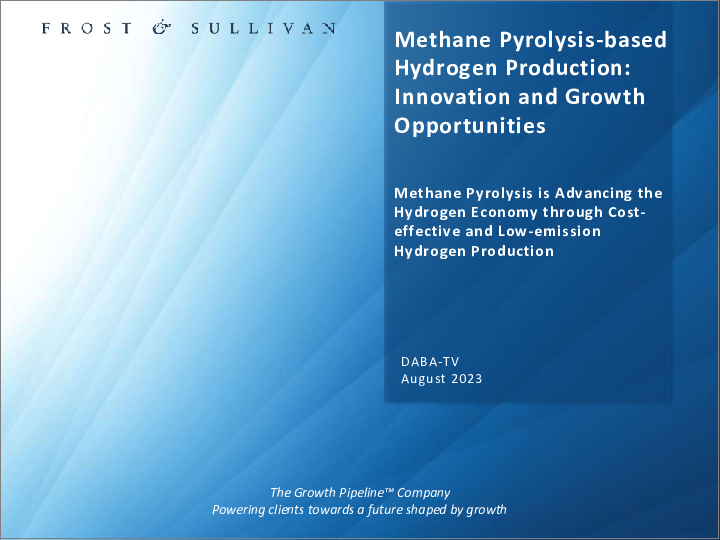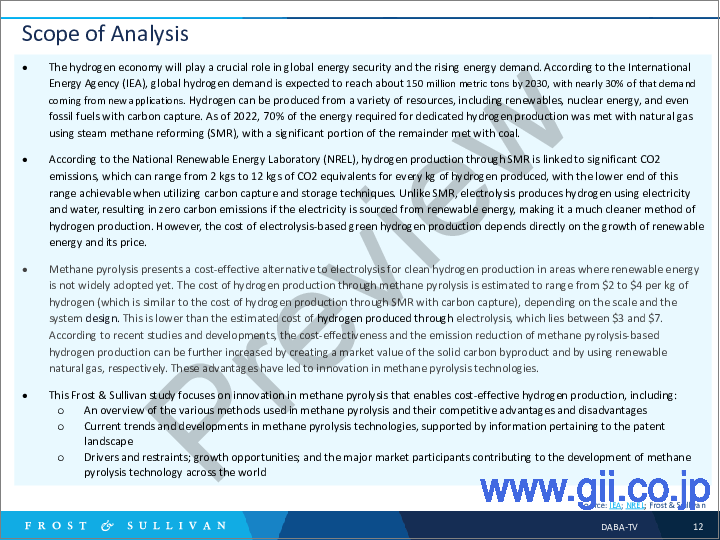|
|
市場調査レポート
商品コード
1348572
メタン熱分解による水素製造:イノベーションと成長機会Methane Pyrolysis-based Hydrogen Production: Innovation and Growth Opportunities |
||||||
|
|||||||
| メタン熱分解による水素製造:イノベーションと成長機会 |
|
出版日: 2023年08月29日
発行: Frost & Sullivan
ページ情報: 英文 42 Pages
納期: 即日から翌営業日
|
- 全表示
- 概要
- 目次
メタン熱分解は費用対効果に優れ、低排出ガスの水素製造を通じて水素経済を促進する
低炭素で水素ベースの経済へのシフトに伴い、エネルギー業界は、水蒸気メタン改質(SMR)よりも炭素排出量が大幅に少なく、既存の電解ベースのグリーン水素製造よりも経済的な代替技術を提供するメタン熱分解(ターコイズ水素)など、より費用対効果の高い持続可能な技術の探求を促しています。メタン熱分解の費用対効果は、他の競合技術では生成されない固形炭素の有効利用により、さらに向上します。生成される固形炭素は、エレクトロニクス、エネルギー貯蔵システム、タイヤ生産、農業添加物、建設資材など、さまざまな分野に応用できる可能性があります。現在、メタン熱分解の研究、開発、商業化の最前線にいるのは新興企業です。調査には、メタン分解のための熱、熱触媒、プラズマ分解法が含まれ、それぞれの方法に独自の利点があります。
フロスト&サリバンの本調査は、メタン熱分解と従来の水素製造技術(SMRおよび水電解)との比較分析から始まります。メタン熱分解による水素製造の多面的な側面をカバーし、熱、熱触媒、プラズマ熱分解プロセスの概要を提供しています。各方法の強みと課題を評価し、各分野のパイオニア企業を紹介しています。さらに、技術の推進力と課題についての洞察を提供し、メタン熱分解に関連する様々なプロセスの技術経済分析を提供しています。また、特許状況を網羅し、メタン熱分解技術の採用を促進する上で極めて重要な役割を果たすと予測される成長機会についても包括的な分析を提供しています。
目次
戦略的課題
- なぜ成長が難しくなっているのか?The Strategic Imperative 8(TM):成長を阻む要因
- The Strategic Imperative 8(TM)
- メタン熱分解ベースの水素製造における上位3つの戦略的重要事項の影響
- 成長機会が燃料となるGrowth Pipeline Engine(TM)
- 調査手法
成長機会分析
- 分析範囲
- 成長促進要因
- 成長阻害要因
- 低炭素水素製造技術:比較
メタン熱分解ベースの水素製造:技術分析
- 調査概要とセグメンテーション
- メタン熱分解:技術概要とバリューチェーン
- 高温環境下でメタンを水素と低級炭素に変換する熱分解
- 触媒熱分解は、メタンの水素と高品質固体炭素への分解を促進します。
- プラズマベースの熱分解により、高いメタン転換率で高純度水素を製造
- メタン熱分解技術:比較分析
イノベーション・エコシステム
- メタンの触媒分解、非触媒熱分解、プラズマ分解:重要な参加企業
- モノリスの大規模メタン熱分解プラント:ケーススタディとロードマップ
成長分析
- 米国がメタン熱分解に基づく水素製造の特許状況をリード
- 新興経済諸国が資金調達エコシステムを独占
成長機会の世界
- 成長機会1:炭素排出を大幅に削減する再生可能天然ガス(RNG)ベースの水素製造
- 成長機会2:追加的な収益源としてのメタン熱分解からのグラフェンとナノチューブ
- 成長機会3:メタン熱分解における熱生成のための先進原子炉の利用
付録
- 技術成熟度レベル(TRL):説明
次のステップ
- 次のステップ
- なぜフロストなのか、なぜ今なのか?
- 免責事項
Methane Pyrolysis is Advancing the Hydrogen Economy through Cost-effective and Low-emission Hydrogen Production
The shift to a low-carbon, hydrogen-based economy is prompting the energy industry to explore more cost-effective and sustainable technologies, including methane pyrolysis (turquoise hydrogen), which offers significantly lower carbon emissions than steam methane reforming (SMR) and provides a more economical alternative to existing electrolysis-based green hydrogen production. Methane pyrolysis's cost-effectiveness can be further enhanced through the effective utilization of the solid carbon byproduct, which none of the other competing technologies produce. The solid carbon produced has potential applications across diverse sectors, such as electronics, energy storage systems, tire production, agricultural additives, and construction materials. Currently, emerging companies are at the forefront of methane pyrolysis research, development, and commercialization. Research encompasses thermal, thermocatalytic, and plasma decomposition methods for methane cracking, with each method offering unique advantages.
This Frost & Sullivan study opens by offering a comparative analysis of methane pyrolysis with conventional hydrogen production technologies (SMR and water electrolysis). It covers multiple aspects of hydrogen production through methane pyrolysis, providing an overview of the thermal, thermocatalytic, and plasma pyrolysis processes. The study evaluates each method's strengths and challenges and highlights the pioneering companies in each segment. In addition, it offers insight into the technology's driving forces and challenges and provides a techno-economic analysis of the various processes associated with methane pyrolysis. It also covers the patent landscape and offers a comprehensive analysis of the growth opportunities projected to play a pivotal role in driving the adoption of methane pyrolysis technology.
Table of Contents
Strategic Imperatives
- Why Is It Increasingly Difficult to Grow?The Strategic Imperative 8™: Factors Creating Pressure on Growth
- The Strategic Imperative 8™
- The Impact of the Top 3 Strategic Imperatives on Methane Pyrolysis-based Hydrogen Production
- Growth Opportunities Fuel the Growth Pipeline Engine™
- Research Methodology
Growth Opportunity Analysis
- Scope of Analysis
- Growth Drivers
- Growth Restraints
- Low-carbon Hydrogen Production Technologies: A Comparison
Methane Pyrolysis-based Hydrogen Production: Technology Analysis
- Research Summary and Segmentation
- Methane Pyrolysis: Technology Description and Value Chain
- Thermal Pyrolysis Converts Methane into Hydrogen and Low-grade Carbon in a High-temperature Environment
- Catalytic Pyrolysis Accelerates Methane's Breakdown into Hydrogen and High-quality Solid Carbon
- Plasma-based Pyrolysis Facilitates a High Methane Conversion Rate to Produce High-purity Hydrogen
- Methane Pyrolysis Technologies: A Comparative Analysis
Innovation Ecosystem
- Catalytic, Noncatalytic Thermal, and Plasma Decomposition of Methane: Important Participants
- Monolith's Large-scale Methane Pyrolysis Plant: Case Study and Road Map
Growth Analysis
- The United States Leads the Methane Pyrolysis-based Hydrogen Production Patent Landscape
- Developed Economies Dominate the Funding Ecosystem
Growth Opportunity Universe
- Growth Opportunity 1: Renewable Natural Gas (RNG)-based Hydrogen Production for Drastically Reduced Carbon Emissions
- Growth Opportunity 2: Graphene and Nanotubes from Methane Pyrolysis as Additional Revenue Streams
- Growth Opportunity 3: Utilizing Advanced Nuclear Reactors for Heat Generation in Methane Pyrolysis
Appendix
- Technology Readiness Levels (TRL): Explanation
Next Steps
- Your Next Steps
- Why Frost, Why Now?
- Legal Disclaimer






